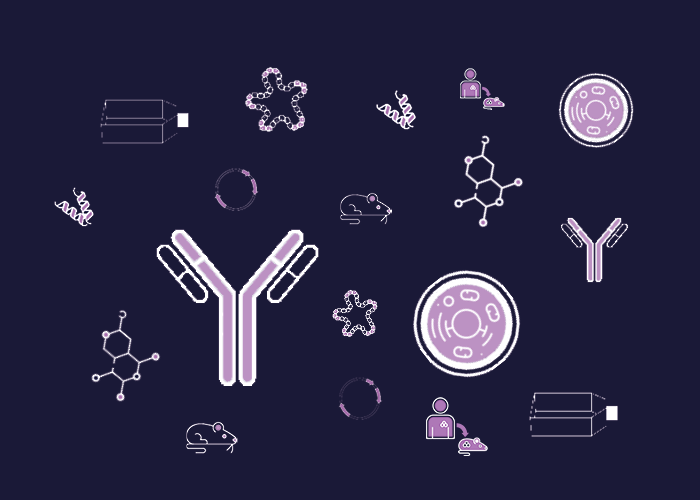Cat. #151472
Anti-EBNA2 [PE2] mAb
Cat. #: 151472
Sub-type: Primary antibody
Unit size: 100 ug
Availability: 3-4 weeks
Target: Epstein Barr Virus Encoded Nuclear Antigen 2 (EBNA2)
Class: Monoclonal
Application: IHC ; IF ; IP ; WB ; ChIP-seq
Reactivity: Human ; Virus
Host: Mouse
£300.00
This fee is applicable only for non-profit organisations. If you are a for-profit organisation or a researcher working on commercially-sponsored academic research, you will need to contact our licensing team for a commercial use license.
Contributor
Inventor: Martin Rowe
Institute: University of Birmingham, UK
Tool Details
*FOR RESEARCH USE ONLY (for other uses, please contact the licensing team)
- Name: Anti-EBNA2 [PE2] mAb
- Alternate name: EBNA2 antibody; EBV antibody; EBV nuclear antigen 2 antibody; Epstein Barr nuclear antigen 2 antibody; HHV4 antibody Human; Herpesvirus 4 antibody
- Research fields: Immunology;Microbiology
- Clone: PE2
- Tool sub type: Primary antibody
- Class: Monoclonal
- Conjugation: Unconjugated
- Molecular weight: 52 kDa
- Reactivity: Human ; Virus
- Host: Mouse
- Application: IHC ; IF ; IP ; WB ; ChIP-seq
- Description: Anti-EBNA2 [PE2] is mouse monoclonal antibody to Epstein Barr Virus Encoded Nuclear Antigen (EBNA) 2. The Epstein-Barr virus (EBV) is a herpes virus and one of the most common viruses in humans. The EBNA 2 protein acts as a transcriptional activator of several viral and cellular genes. This antibody recognises a shared epitope between the EBNA 2A and 2B proteins. EBNA2 expression in nasopharyngeal carcinoma biopsies was studied more extensively with anti-EBNA2. The EBNA 2-specific mAb PE2 is particularly valuable as it recognises the two alternative forms of this antigen, EBNA 2A and 2B.
- Immunogen: Recombinant fusion protein against EBNA2. The immunogen was a beta-gal fusion protein from plasmid pKH-2A10 that contains aa 341-480 of B95.8 type EBNA2A (Fig 4 - Young et al. 1989).
- Immunogen uniprot id: P12978
- Isotype: IgG1 kappa
- Myeloma used: P3X63Ag8.653
- Recommended controls: Immunohistochemistry (Acetone fixed): EBV positive Raji cell Line. Western blotting: B95-8 cell
Target Details
- Target: Epstein Barr Virus Encoded Nuclear Antigen 2 (EBNA2)
- Molecular weight: 52 kDa
- Tissue cell line specificity: Immunohistochemistry (Acetone fixed): EBV positive Raji cell Line. Western blotting: B95-8 cell
- Target background: The Epstein-Barr Virus (EBV), also called Human herpesvirus 4 (HHV-4), is a virus of the herpes family and is one of the most common viruses in humans. EBNA2 is one of the few genes of Epstein-Barr virus which are necessary for immortalisation of human primary B lymphocytes. EBV is associated with several B-cell lymphomas and epithelial nasopharyngeal carcinoma. The EBNA2 protein acts as a transcriptional activator of several viral and cellular genes. There are two alternative forms of EBNA2: EBNA2A and EBNA2B.
Applications
- Application: IHC ; IF ; IP ; WB ; ChIP-seq
Handling
- Format: Liquid
- Concentration: 1 mg/ml
- Unit size: 100 ug
- Storage buffer: PBS with 0.02% azide
- Storage conditions: Store at -20° C frozen. Avoid repeated freeze / thaw cycles
- Shipping conditions: Dry ice
References
- Brocard et al. 2018. Nucleic Acids Res. 46(7):3707-3725. PMID: 29385536.
- Wille et al. 2017. J Virol. 91(5). PMID: 28003489.
- David et al. 2017. Haematologica. 102(5): 883-894. PMID: 28232371.
- Wille et al. 2017. J Virol. PMID: 28003489.
- Wang et al. 2015. J Virol. 90(6):2906-2919. PMID: 26719268.
- Pujals et al. 2015. Autophagy. PMID: 26565591.
- Gibson et al. 2011. Am J Surg Pathol. 35(6):807-815. PMID: 21552113.
- Boshoff et al. 1998. Blood. 91(5):1671-1679. PMID: 9473233.
- Brink et al. 1997. J Clin Pathol. 50(11):911-918. PMID: 9462239.
- Niedobitek et al. 1995. Blood. 86(2):659-665. PMID: 7605996.
- Rowe et al. 1991. J Exp Med. 173(1):147-158. PMID: 1845872.
- Young et al. 1989. N Engl J Med. 321(16):1080-1085. PMID: 2552313.
- Young et al. 1988. J Gen Virol. 69:1051-1065. PMID: 2836550.





